EC721 Child Study Report: Observation, Analysis & Development
VerifiedAdded on 2023/04/17
|17
|4204
|123
Report
AI Summary
This report presents a child study of Aryan Singh, a 3-year-old Indian-Asian child residing in New Zealand. The study includes background information, observations, and analysis of his physical, cognitive, language, social-emotional, and spiritual development. Observations revealed Aryan's physical fitness, well-developed fine motor skills, and cognitive abilities, including memory and problem-solving. His language development is progressing well, with expressive communication skills. The report also touches on his emotional and social development, highlighting his ability to form positive relationships. The analysis incorporates relevant child development principles, theories, and socioecological factors, referencing theorists like Albert Bandura and Lev Vygotsky and frameworks such as Te Whariki. The study emphasizes the importance of early year educators in providing a supportive environment for holistic child development.
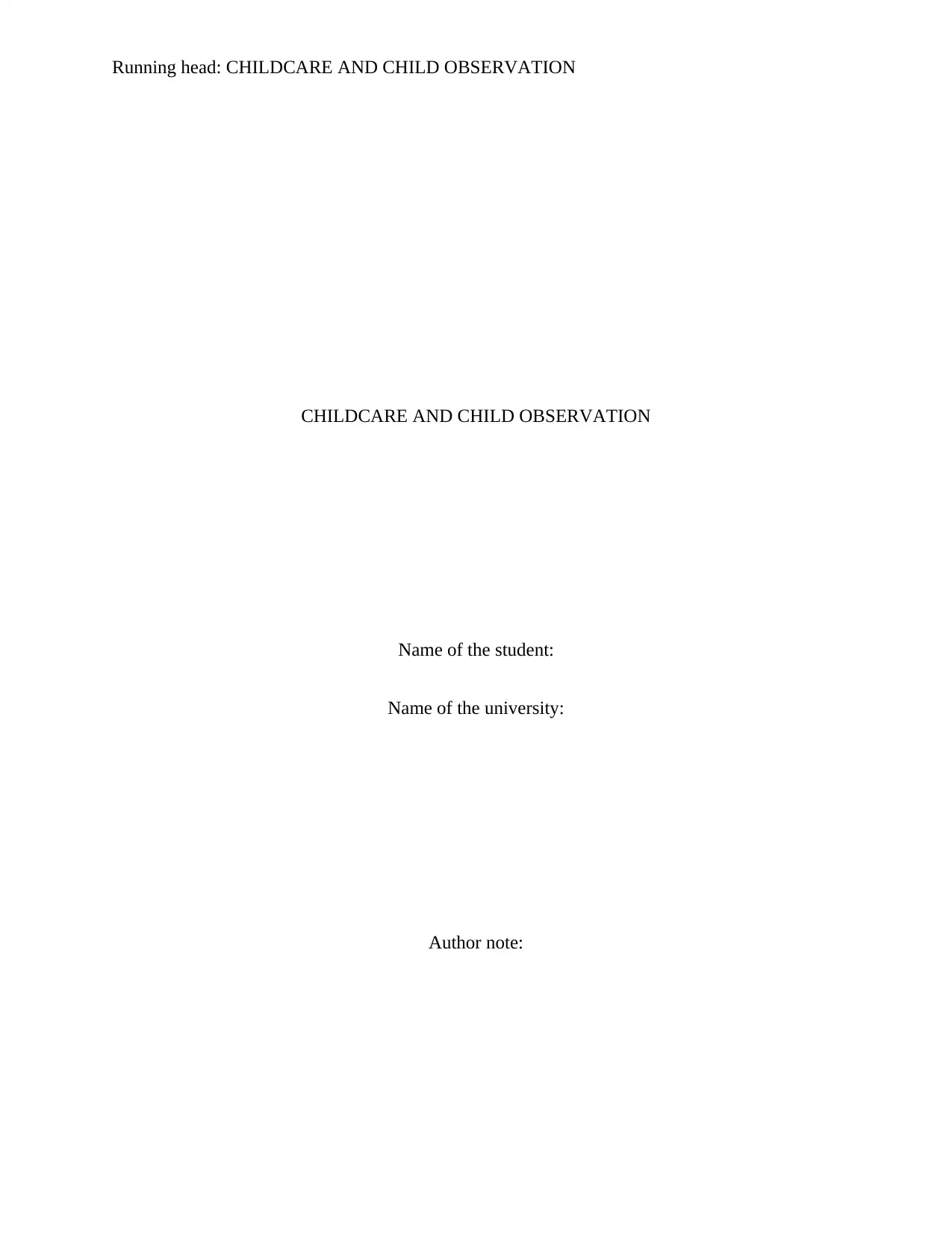
Running head: CHILDCARE AND CHILD OBSERVATION
CHILDCARE AND CHILD OBSERVATION
Name of the student:
Name of the university:
Author note:
CHILDCARE AND CHILD OBSERVATION
Name of the student:
Name of the university:
Author note:
Paraphrase This Document
Need a fresh take? Get an instant paraphrase of this document with our AI Paraphraser
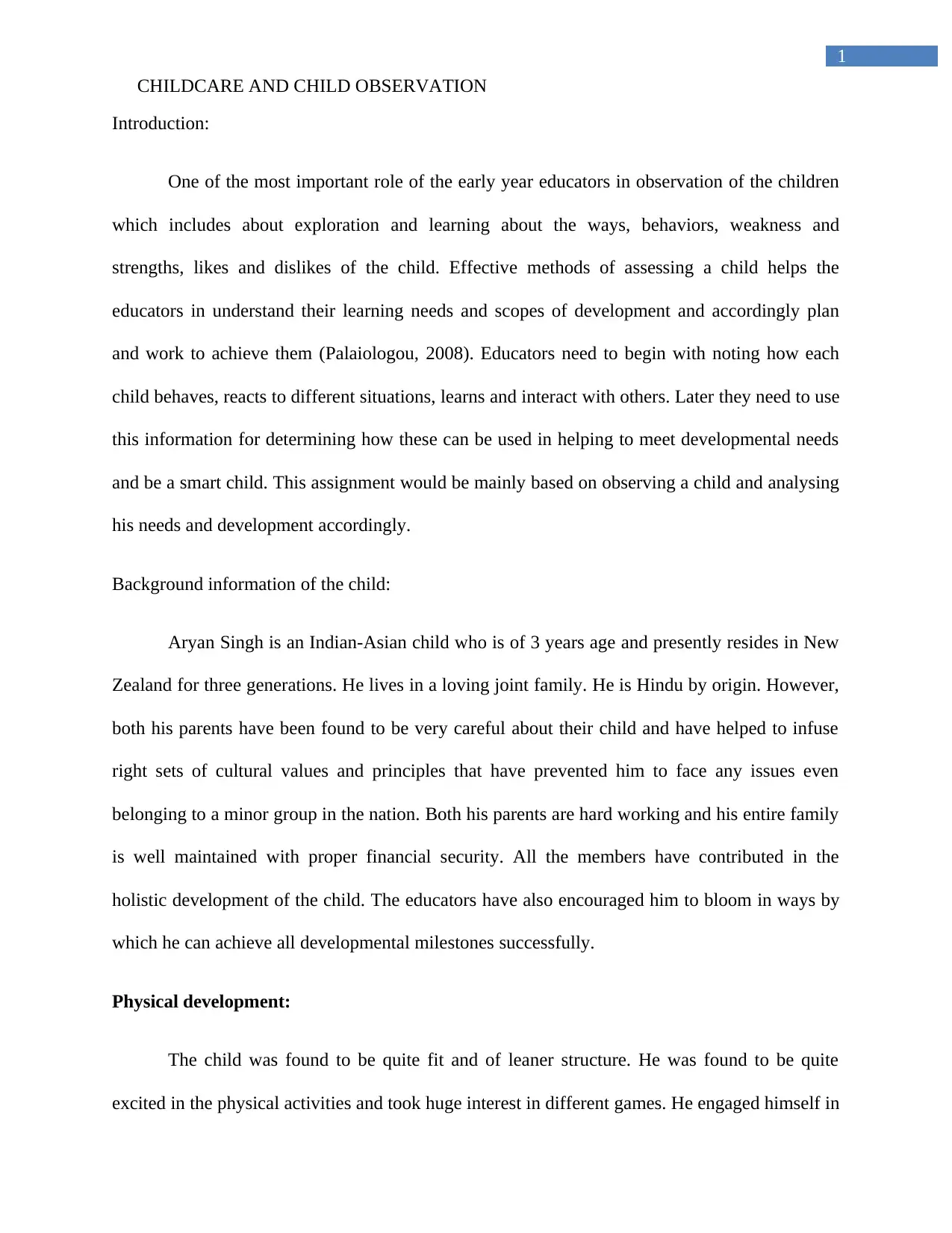
1
CHILDCARE AND CHILD OBSERVATION
Introduction:
One of the most important role of the early year educators in observation of the children
which includes about exploration and learning about the ways, behaviors, weakness and
strengths, likes and dislikes of the child. Effective methods of assessing a child helps the
educators in understand their learning needs and scopes of development and accordingly plan
and work to achieve them (Palaiologou, 2008). Educators need to begin with noting how each
child behaves, reacts to different situations, learns and interact with others. Later they need to use
this information for determining how these can be used in helping to meet developmental needs
and be a smart child. This assignment would be mainly based on observing a child and analysing
his needs and development accordingly.
Background information of the child:
Aryan Singh is an Indian-Asian child who is of 3 years age and presently resides in New
Zealand for three generations. He lives in a loving joint family. He is Hindu by origin. However,
both his parents have been found to be very careful about their child and have helped to infuse
right sets of cultural values and principles that have prevented him to face any issues even
belonging to a minor group in the nation. Both his parents are hard working and his entire family
is well maintained with proper financial security. All the members have contributed in the
holistic development of the child. The educators have also encouraged him to bloom in ways by
which he can achieve all developmental milestones successfully.
Physical development:
The child was found to be quite fit and of leaner structure. He was found to be quite
excited in the physical activities and took huge interest in different games. He engaged himself in
CHILDCARE AND CHILD OBSERVATION
Introduction:
One of the most important role of the early year educators in observation of the children
which includes about exploration and learning about the ways, behaviors, weakness and
strengths, likes and dislikes of the child. Effective methods of assessing a child helps the
educators in understand their learning needs and scopes of development and accordingly plan
and work to achieve them (Palaiologou, 2008). Educators need to begin with noting how each
child behaves, reacts to different situations, learns and interact with others. Later they need to use
this information for determining how these can be used in helping to meet developmental needs
and be a smart child. This assignment would be mainly based on observing a child and analysing
his needs and development accordingly.
Background information of the child:
Aryan Singh is an Indian-Asian child who is of 3 years age and presently resides in New
Zealand for three generations. He lives in a loving joint family. He is Hindu by origin. However,
both his parents have been found to be very careful about their child and have helped to infuse
right sets of cultural values and principles that have prevented him to face any issues even
belonging to a minor group in the nation. Both his parents are hard working and his entire family
is well maintained with proper financial security. All the members have contributed in the
holistic development of the child. The educators have also encouraged him to bloom in ways by
which he can achieve all developmental milestones successfully.
Physical development:
The child was found to be quite fit and of leaner structure. He was found to be quite
excited in the physical activities and took huge interest in different games. He engaged himself in
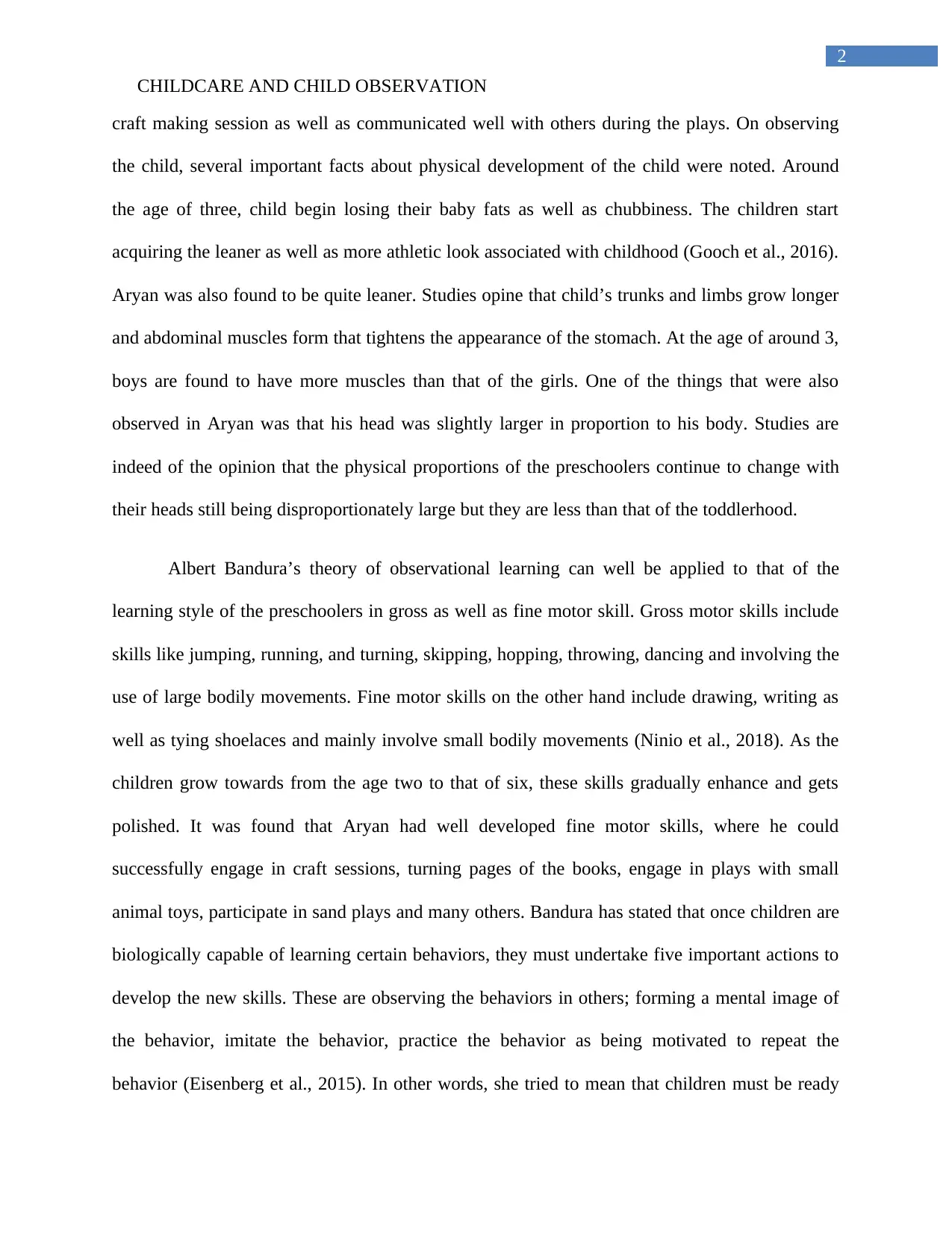
2
CHILDCARE AND CHILD OBSERVATION
craft making session as well as communicated well with others during the plays. On observing
the child, several important facts about physical development of the child were noted. Around
the age of three, child begin losing their baby fats as well as chubbiness. The children start
acquiring the leaner as well as more athletic look associated with childhood (Gooch et al., 2016).
Aryan was also found to be quite leaner. Studies opine that child’s trunks and limbs grow longer
and abdominal muscles form that tightens the appearance of the stomach. At the age of around 3,
boys are found to have more muscles than that of the girls. One of the things that were also
observed in Aryan was that his head was slightly larger in proportion to his body. Studies are
indeed of the opinion that the physical proportions of the preschoolers continue to change with
their heads still being disproportionately large but they are less than that of the toddlerhood.
Albert Bandura’s theory of observational learning can well be applied to that of the
learning style of the preschoolers in gross as well as fine motor skill. Gross motor skills include
skills like jumping, running, and turning, skipping, hopping, throwing, dancing and involving the
use of large bodily movements. Fine motor skills on the other hand include drawing, writing as
well as tying shoelaces and mainly involve small bodily movements (Ninio et al., 2018). As the
children grow towards from the age two to that of six, these skills gradually enhance and gets
polished. It was found that Aryan had well developed fine motor skills, where he could
successfully engage in craft sessions, turning pages of the books, engage in plays with small
animal toys, participate in sand plays and many others. Bandura has stated that once children are
biologically capable of learning certain behaviors, they must undertake five important actions to
develop the new skills. These are observing the behaviors in others; forming a mental image of
the behavior, imitate the behavior, practice the behavior as being motivated to repeat the
behavior (Eisenberg et al., 2015). In other words, she tried to mean that children must be ready
CHILDCARE AND CHILD OBSERVATION
craft making session as well as communicated well with others during the plays. On observing
the child, several important facts about physical development of the child were noted. Around
the age of three, child begin losing their baby fats as well as chubbiness. The children start
acquiring the leaner as well as more athletic look associated with childhood (Gooch et al., 2016).
Aryan was also found to be quite leaner. Studies opine that child’s trunks and limbs grow longer
and abdominal muscles form that tightens the appearance of the stomach. At the age of around 3,
boys are found to have more muscles than that of the girls. One of the things that were also
observed in Aryan was that his head was slightly larger in proportion to his body. Studies are
indeed of the opinion that the physical proportions of the preschoolers continue to change with
their heads still being disproportionately large but they are less than that of the toddlerhood.
Albert Bandura’s theory of observational learning can well be applied to that of the
learning style of the preschoolers in gross as well as fine motor skill. Gross motor skills include
skills like jumping, running, and turning, skipping, hopping, throwing, dancing and involving the
use of large bodily movements. Fine motor skills on the other hand include drawing, writing as
well as tying shoelaces and mainly involve small bodily movements (Ninio et al., 2018). As the
children grow towards from the age two to that of six, these skills gradually enhance and gets
polished. It was found that Aryan had well developed fine motor skills, where he could
successfully engage in craft sessions, turning pages of the books, engage in plays with small
animal toys, participate in sand plays and many others. Bandura has stated that once children are
biologically capable of learning certain behaviors, they must undertake five important actions to
develop the new skills. These are observing the behaviors in others; forming a mental image of
the behavior, imitate the behavior, practice the behavior as being motivated to repeat the
behavior (Eisenberg et al., 2015). In other words, she tried to mean that children must be ready
⊘ This is a preview!⊘
Do you want full access?
Subscribe today to unlock all pages.

Trusted by 1+ million students worldwide
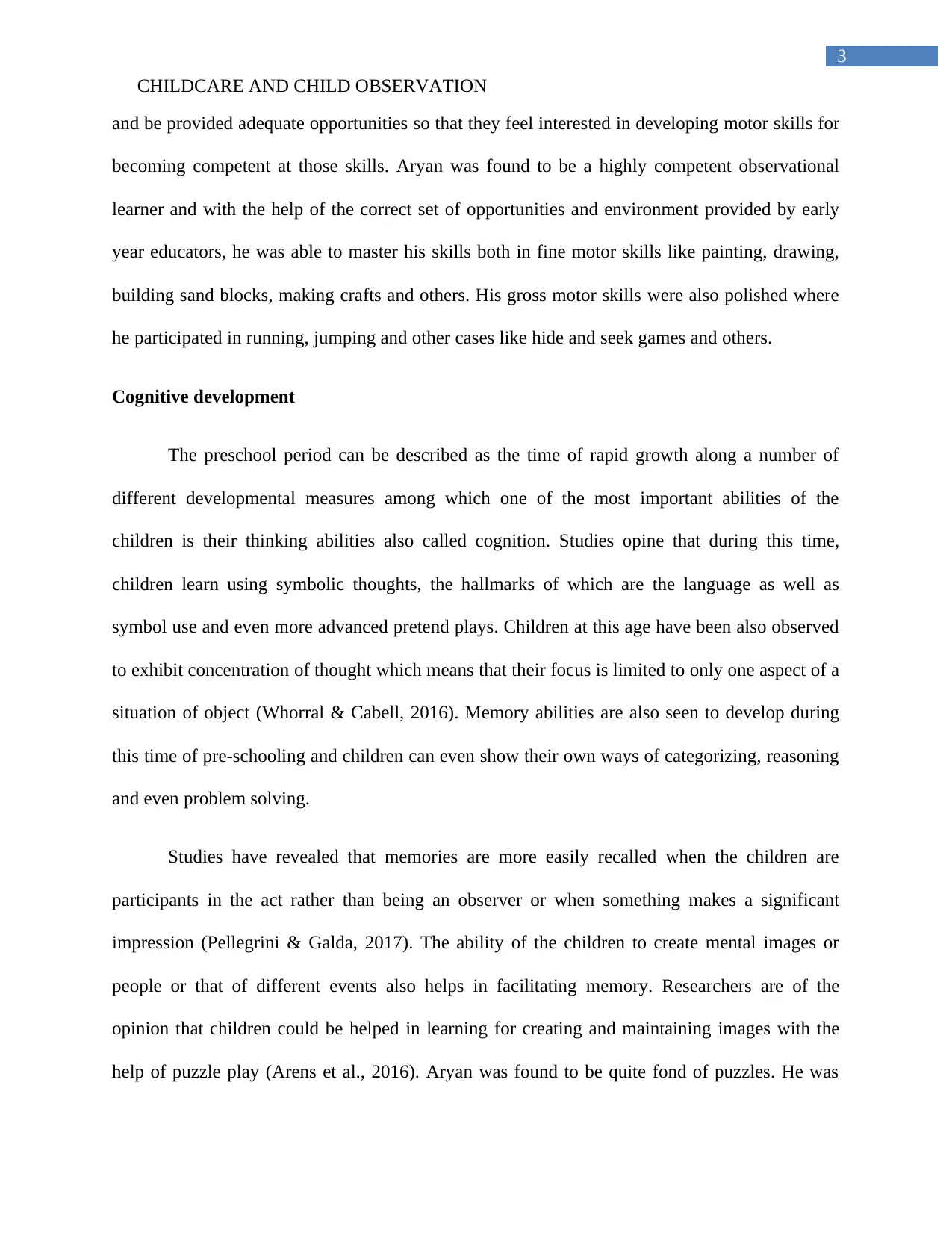
3
CHILDCARE AND CHILD OBSERVATION
and be provided adequate opportunities so that they feel interested in developing motor skills for
becoming competent at those skills. Aryan was found to be a highly competent observational
learner and with the help of the correct set of opportunities and environment provided by early
year educators, he was able to master his skills both in fine motor skills like painting, drawing,
building sand blocks, making crafts and others. His gross motor skills were also polished where
he participated in running, jumping and other cases like hide and seek games and others.
Cognitive development
The preschool period can be described as the time of rapid growth along a number of
different developmental measures among which one of the most important abilities of the
children is their thinking abilities also called cognition. Studies opine that during this time,
children learn using symbolic thoughts, the hallmarks of which are the language as well as
symbol use and even more advanced pretend plays. Children at this age have been also observed
to exhibit concentration of thought which means that their focus is limited to only one aspect of a
situation of object (Whorral & Cabell, 2016). Memory abilities are also seen to develop during
this time of pre-schooling and children can even show their own ways of categorizing, reasoning
and even problem solving.
Studies have revealed that memories are more easily recalled when the children are
participants in the act rather than being an observer or when something makes a significant
impression (Pellegrini & Galda, 2017). The ability of the children to create mental images or
people or that of different events also helps in facilitating memory. Researchers are of the
opinion that children could be helped in learning for creating and maintaining images with the
help of puzzle play (Arens et al., 2016). Aryan was found to be quite fond of puzzles. He was
CHILDCARE AND CHILD OBSERVATION
and be provided adequate opportunities so that they feel interested in developing motor skills for
becoming competent at those skills. Aryan was found to be a highly competent observational
learner and with the help of the correct set of opportunities and environment provided by early
year educators, he was able to master his skills both in fine motor skills like painting, drawing,
building sand blocks, making crafts and others. His gross motor skills were also polished where
he participated in running, jumping and other cases like hide and seek games and others.
Cognitive development
The preschool period can be described as the time of rapid growth along a number of
different developmental measures among which one of the most important abilities of the
children is their thinking abilities also called cognition. Studies opine that during this time,
children learn using symbolic thoughts, the hallmarks of which are the language as well as
symbol use and even more advanced pretend plays. Children at this age have been also observed
to exhibit concentration of thought which means that their focus is limited to only one aspect of a
situation of object (Whorral & Cabell, 2016). Memory abilities are also seen to develop during
this time of pre-schooling and children can even show their own ways of categorizing, reasoning
and even problem solving.
Studies have revealed that memories are more easily recalled when the children are
participants in the act rather than being an observer or when something makes a significant
impression (Pellegrini & Galda, 2017). The ability of the children to create mental images or
people or that of different events also helps in facilitating memory. Researchers are of the
opinion that children could be helped in learning for creating and maintaining images with the
help of puzzle play (Arens et al., 2016). Aryan was found to be quite fond of puzzles. He was
Paraphrase This Document
Need a fresh take? Get an instant paraphrase of this document with our AI Paraphraser
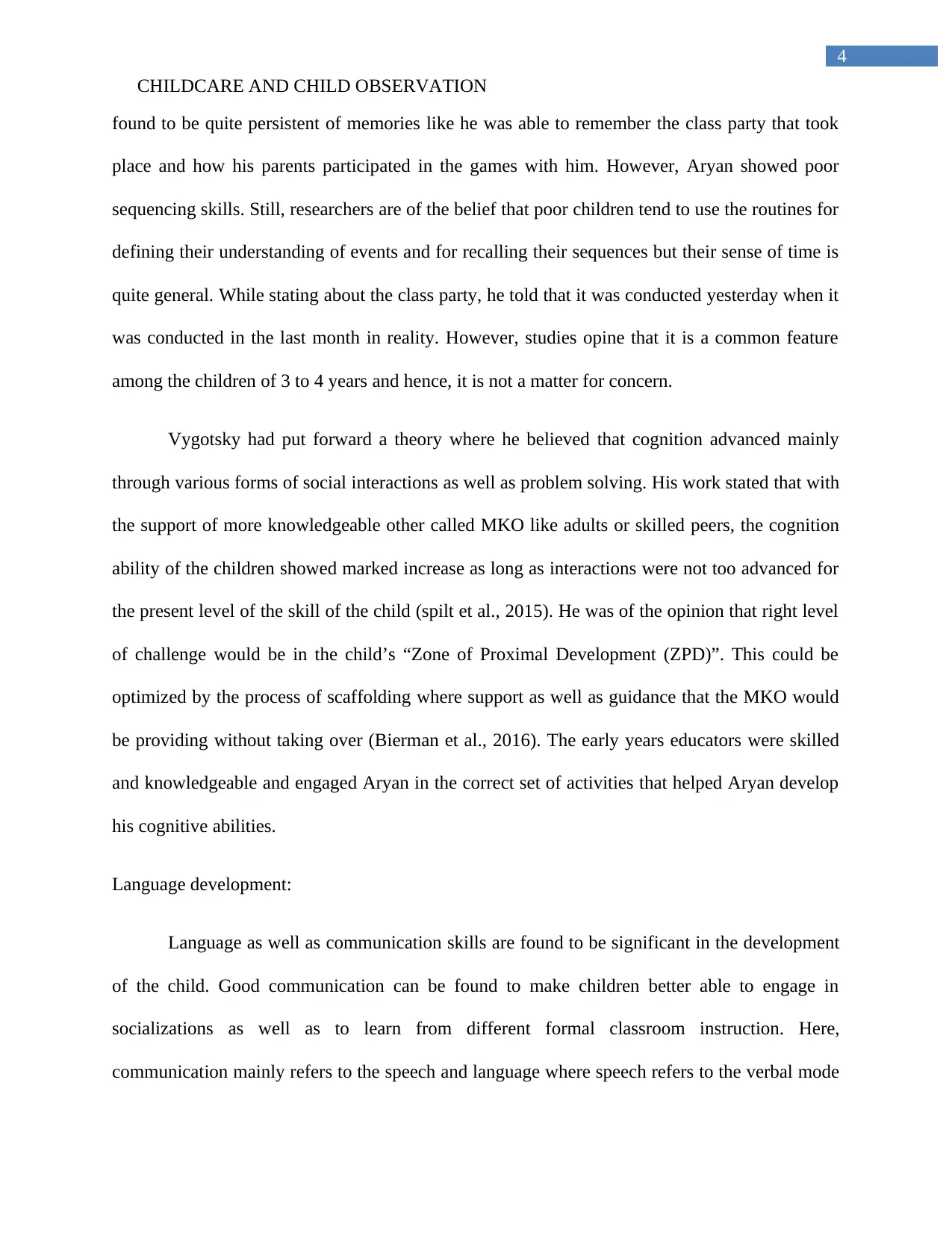
4
CHILDCARE AND CHILD OBSERVATION
found to be quite persistent of memories like he was able to remember the class party that took
place and how his parents participated in the games with him. However, Aryan showed poor
sequencing skills. Still, researchers are of the belief that poor children tend to use the routines for
defining their understanding of events and for recalling their sequences but their sense of time is
quite general. While stating about the class party, he told that it was conducted yesterday when it
was conducted in the last month in reality. However, studies opine that it is a common feature
among the children of 3 to 4 years and hence, it is not a matter for concern.
Vygotsky had put forward a theory where he believed that cognition advanced mainly
through various forms of social interactions as well as problem solving. His work stated that with
the support of more knowledgeable other called MKO like adults or skilled peers, the cognition
ability of the children showed marked increase as long as interactions were not too advanced for
the present level of the skill of the child (spilt et al., 2015). He was of the opinion that right level
of challenge would be in the child’s “Zone of Proximal Development (ZPD)”. This could be
optimized by the process of scaffolding where support as well as guidance that the MKO would
be providing without taking over (Bierman et al., 2016). The early years educators were skilled
and knowledgeable and engaged Aryan in the correct set of activities that helped Aryan develop
his cognitive abilities.
Language development:
Language as well as communication skills are found to be significant in the development
of the child. Good communication can be found to make children better able to engage in
socializations as well as to learn from different formal classroom instruction. Here,
communication mainly refers to the speech and language where speech refers to the verbal mode
CHILDCARE AND CHILD OBSERVATION
found to be quite persistent of memories like he was able to remember the class party that took
place and how his parents participated in the games with him. However, Aryan showed poor
sequencing skills. Still, researchers are of the belief that poor children tend to use the routines for
defining their understanding of events and for recalling their sequences but their sense of time is
quite general. While stating about the class party, he told that it was conducted yesterday when it
was conducted in the last month in reality. However, studies opine that it is a common feature
among the children of 3 to 4 years and hence, it is not a matter for concern.
Vygotsky had put forward a theory where he believed that cognition advanced mainly
through various forms of social interactions as well as problem solving. His work stated that with
the support of more knowledgeable other called MKO like adults or skilled peers, the cognition
ability of the children showed marked increase as long as interactions were not too advanced for
the present level of the skill of the child (spilt et al., 2015). He was of the opinion that right level
of challenge would be in the child’s “Zone of Proximal Development (ZPD)”. This could be
optimized by the process of scaffolding where support as well as guidance that the MKO would
be providing without taking over (Bierman et al., 2016). The early years educators were skilled
and knowledgeable and engaged Aryan in the correct set of activities that helped Aryan develop
his cognitive abilities.
Language development:
Language as well as communication skills are found to be significant in the development
of the child. Good communication can be found to make children better able to engage in
socializations as well as to learn from different formal classroom instruction. Here,
communication mainly refers to the speech and language where speech refers to the verbal mode
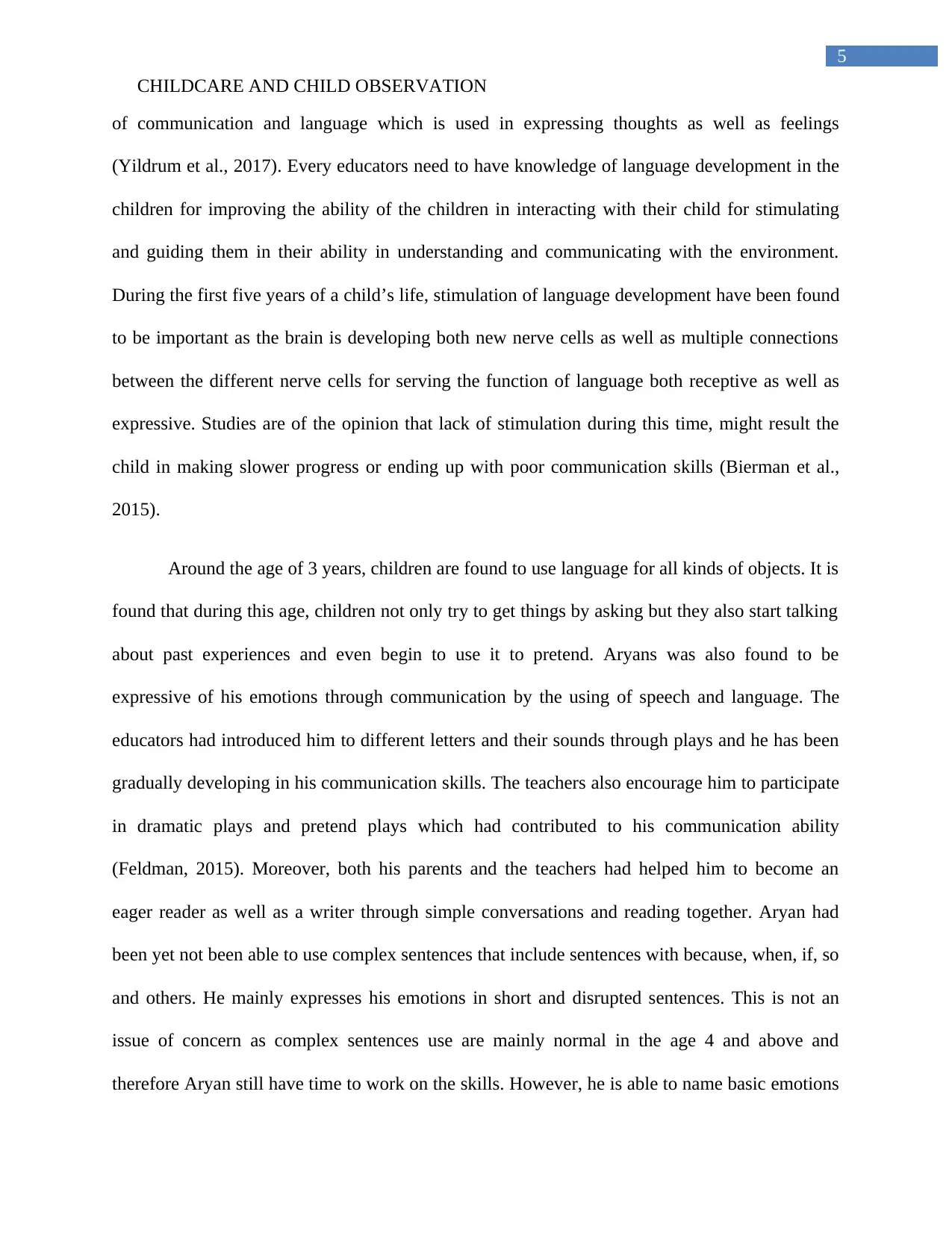
5
CHILDCARE AND CHILD OBSERVATION
of communication and language which is used in expressing thoughts as well as feelings
(Yildrum et al., 2017). Every educators need to have knowledge of language development in the
children for improving the ability of the children in interacting with their child for stimulating
and guiding them in their ability in understanding and communicating with the environment.
During the first five years of a child’s life, stimulation of language development have been found
to be important as the brain is developing both new nerve cells as well as multiple connections
between the different nerve cells for serving the function of language both receptive as well as
expressive. Studies are of the opinion that lack of stimulation during this time, might result the
child in making slower progress or ending up with poor communication skills (Bierman et al.,
2015).
Around the age of 3 years, children are found to use language for all kinds of objects. It is
found that during this age, children not only try to get things by asking but they also start talking
about past experiences and even begin to use it to pretend. Aryans was also found to be
expressive of his emotions through communication by the using of speech and language. The
educators had introduced him to different letters and their sounds through plays and he has been
gradually developing in his communication skills. The teachers also encourage him to participate
in dramatic plays and pretend plays which had contributed to his communication ability
(Feldman, 2015). Moreover, both his parents and the teachers had helped him to become an
eager reader as well as a writer through simple conversations and reading together. Aryan had
been yet not been able to use complex sentences that include sentences with because, when, if, so
and others. He mainly expresses his emotions in short and disrupted sentences. This is not an
issue of concern as complex sentences use are mainly normal in the age 4 and above and
therefore Aryan still have time to work on the skills. However, he is able to name basic emotions
CHILDCARE AND CHILD OBSERVATION
of communication and language which is used in expressing thoughts as well as feelings
(Yildrum et al., 2017). Every educators need to have knowledge of language development in the
children for improving the ability of the children in interacting with their child for stimulating
and guiding them in their ability in understanding and communicating with the environment.
During the first five years of a child’s life, stimulation of language development have been found
to be important as the brain is developing both new nerve cells as well as multiple connections
between the different nerve cells for serving the function of language both receptive as well as
expressive. Studies are of the opinion that lack of stimulation during this time, might result the
child in making slower progress or ending up with poor communication skills (Bierman et al.,
2015).
Around the age of 3 years, children are found to use language for all kinds of objects. It is
found that during this age, children not only try to get things by asking but they also start talking
about past experiences and even begin to use it to pretend. Aryans was also found to be
expressive of his emotions through communication by the using of speech and language. The
educators had introduced him to different letters and their sounds through plays and he has been
gradually developing in his communication skills. The teachers also encourage him to participate
in dramatic plays and pretend plays which had contributed to his communication ability
(Feldman, 2015). Moreover, both his parents and the teachers had helped him to become an
eager reader as well as a writer through simple conversations and reading together. Aryan had
been yet not been able to use complex sentences that include sentences with because, when, if, so
and others. He mainly expresses his emotions in short and disrupted sentences. This is not an
issue of concern as complex sentences use are mainly normal in the age 4 and above and
therefore Aryan still have time to work on the skills. However, he is able to name basic emotions
⊘ This is a preview!⊘
Do you want full access?
Subscribe today to unlock all pages.

Trusted by 1+ million students worldwide
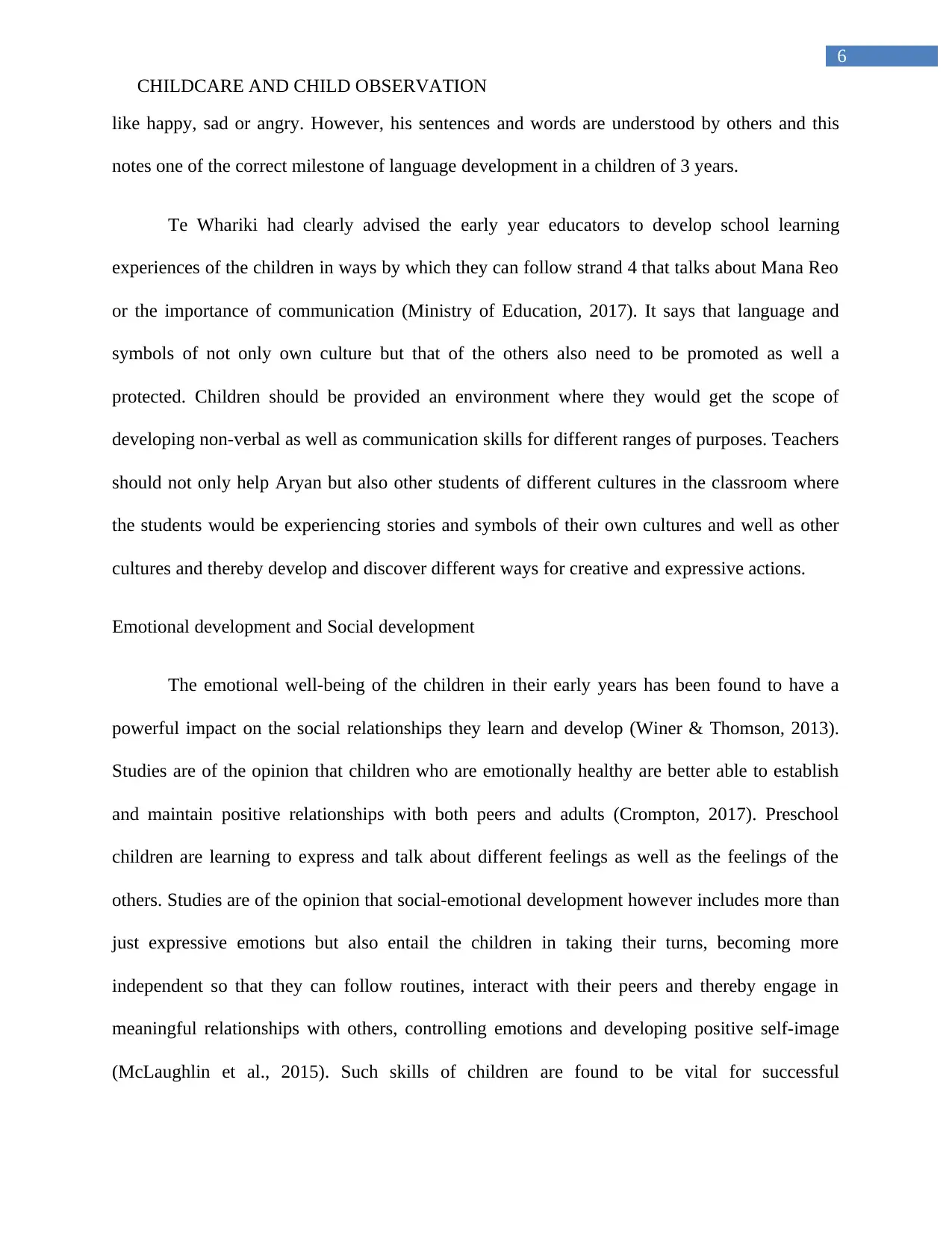
6
CHILDCARE AND CHILD OBSERVATION
like happy, sad or angry. However, his sentences and words are understood by others and this
notes one of the correct milestone of language development in a children of 3 years.
Te Whariki had clearly advised the early year educators to develop school learning
experiences of the children in ways by which they can follow strand 4 that talks about Mana Reo
or the importance of communication (Ministry of Education, 2017). It says that language and
symbols of not only own culture but that of the others also need to be promoted as well a
protected. Children should be provided an environment where they would get the scope of
developing non-verbal as well as communication skills for different ranges of purposes. Teachers
should not only help Aryan but also other students of different cultures in the classroom where
the students would be experiencing stories and symbols of their own cultures and well as other
cultures and thereby develop and discover different ways for creative and expressive actions.
Emotional development and Social development
The emotional well-being of the children in their early years has been found to have a
powerful impact on the social relationships they learn and develop (Winer & Thomson, 2013).
Studies are of the opinion that children who are emotionally healthy are better able to establish
and maintain positive relationships with both peers and adults (Crompton, 2017). Preschool
children are learning to express and talk about different feelings as well as the feelings of the
others. Studies are of the opinion that social-emotional development however includes more than
just expressive emotions but also entail the children in taking their turns, becoming more
independent so that they can follow routines, interact with their peers and thereby engage in
meaningful relationships with others, controlling emotions and developing positive self-image
(McLaughlin et al., 2015). Such skills of children are found to be vital for successful
CHILDCARE AND CHILD OBSERVATION
like happy, sad or angry. However, his sentences and words are understood by others and this
notes one of the correct milestone of language development in a children of 3 years.
Te Whariki had clearly advised the early year educators to develop school learning
experiences of the children in ways by which they can follow strand 4 that talks about Mana Reo
or the importance of communication (Ministry of Education, 2017). It says that language and
symbols of not only own culture but that of the others also need to be promoted as well a
protected. Children should be provided an environment where they would get the scope of
developing non-verbal as well as communication skills for different ranges of purposes. Teachers
should not only help Aryan but also other students of different cultures in the classroom where
the students would be experiencing stories and symbols of their own cultures and well as other
cultures and thereby develop and discover different ways for creative and expressive actions.
Emotional development and Social development
The emotional well-being of the children in their early years has been found to have a
powerful impact on the social relationships they learn and develop (Winer & Thomson, 2013).
Studies are of the opinion that children who are emotionally healthy are better able to establish
and maintain positive relationships with both peers and adults (Crompton, 2017). Preschool
children are learning to express and talk about different feelings as well as the feelings of the
others. Studies are of the opinion that social-emotional development however includes more than
just expressive emotions but also entail the children in taking their turns, becoming more
independent so that they can follow routines, interact with their peers and thereby engage in
meaningful relationships with others, controlling emotions and developing positive self-image
(McLaughlin et al., 2015). Such skills of children are found to be vital for successful
Paraphrase This Document
Need a fresh take? Get an instant paraphrase of this document with our AI Paraphraser
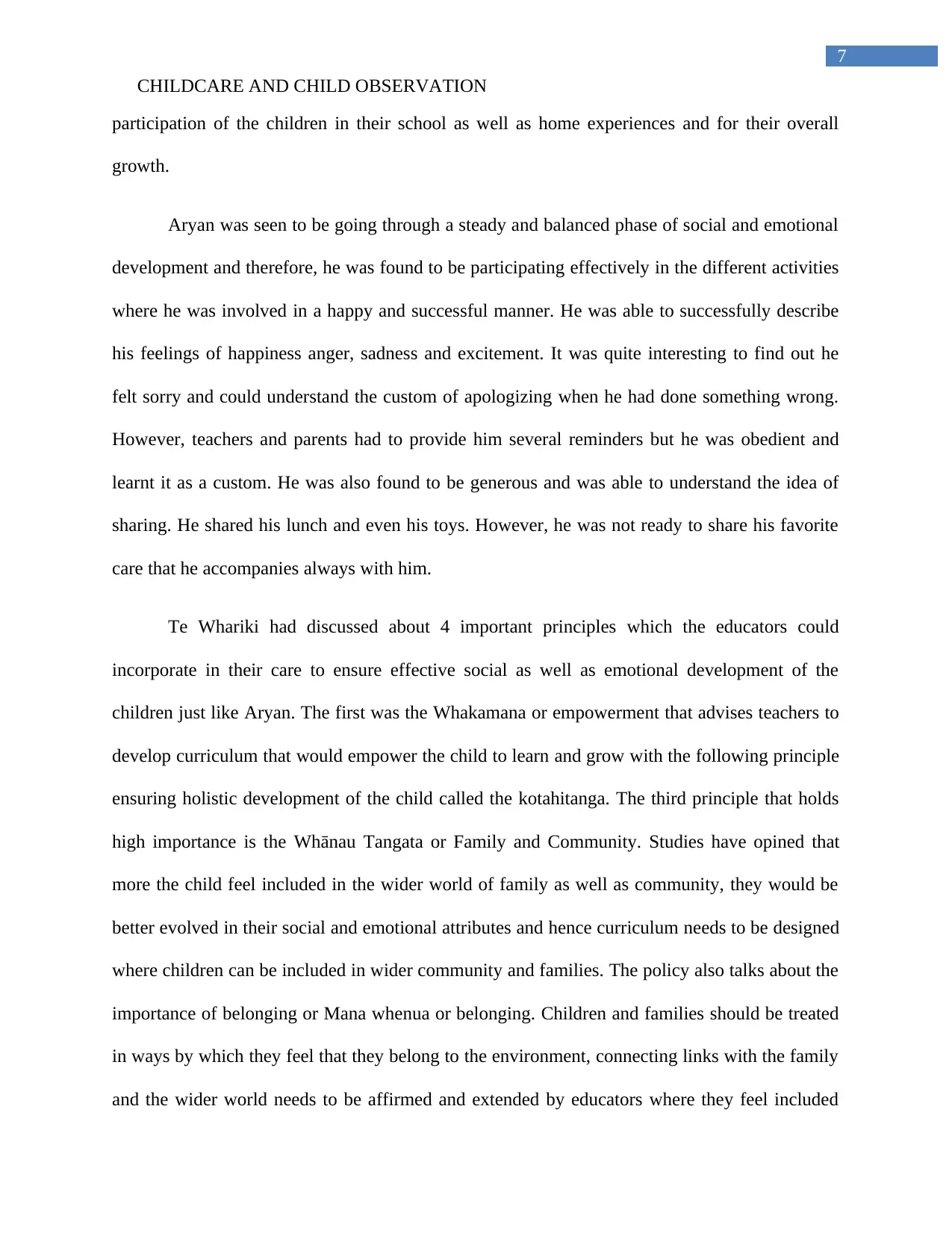
7
CHILDCARE AND CHILD OBSERVATION
participation of the children in their school as well as home experiences and for their overall
growth.
Aryan was seen to be going through a steady and balanced phase of social and emotional
development and therefore, he was found to be participating effectively in the different activities
where he was involved in a happy and successful manner. He was able to successfully describe
his feelings of happiness anger, sadness and excitement. It was quite interesting to find out he
felt sorry and could understand the custom of apologizing when he had done something wrong.
However, teachers and parents had to provide him several reminders but he was obedient and
learnt it as a custom. He was also found to be generous and was able to understand the idea of
sharing. He shared his lunch and even his toys. However, he was not ready to share his favorite
care that he accompanies always with him.
Te Whariki had discussed about 4 important principles which the educators could
incorporate in their care to ensure effective social as well as emotional development of the
children just like Aryan. The first was the Whakamana or empowerment that advises teachers to
develop curriculum that would empower the child to learn and grow with the following principle
ensuring holistic development of the child called the kotahitanga. The third principle that holds
high importance is the Whānau Tangata or Family and Community. Studies have opined that
more the child feel included in the wider world of family as well as community, they would be
better evolved in their social and emotional attributes and hence curriculum needs to be designed
where children can be included in wider community and families. The policy also talks about the
importance of belonging or Mana whenua or belonging. Children and families should be treated
in ways by which they feel that they belong to the environment, connecting links with the family
and the wider world needs to be affirmed and extended by educators where they feel included
CHILDCARE AND CHILD OBSERVATION
participation of the children in their school as well as home experiences and for their overall
growth.
Aryan was seen to be going through a steady and balanced phase of social and emotional
development and therefore, he was found to be participating effectively in the different activities
where he was involved in a happy and successful manner. He was able to successfully describe
his feelings of happiness anger, sadness and excitement. It was quite interesting to find out he
felt sorry and could understand the custom of apologizing when he had done something wrong.
However, teachers and parents had to provide him several reminders but he was obedient and
learnt it as a custom. He was also found to be generous and was able to understand the idea of
sharing. He shared his lunch and even his toys. However, he was not ready to share his favorite
care that he accompanies always with him.
Te Whariki had discussed about 4 important principles which the educators could
incorporate in their care to ensure effective social as well as emotional development of the
children just like Aryan. The first was the Whakamana or empowerment that advises teachers to
develop curriculum that would empower the child to learn and grow with the following principle
ensuring holistic development of the child called the kotahitanga. The third principle that holds
high importance is the Whānau Tangata or Family and Community. Studies have opined that
more the child feel included in the wider world of family as well as community, they would be
better evolved in their social and emotional attributes and hence curriculum needs to be designed
where children can be included in wider community and families. The policy also talks about the
importance of belonging or Mana whenua or belonging. Children and families should be treated
in ways by which they feel that they belong to the environment, connecting links with the family
and the wider world needs to be affirmed and extended by educators where they feel included
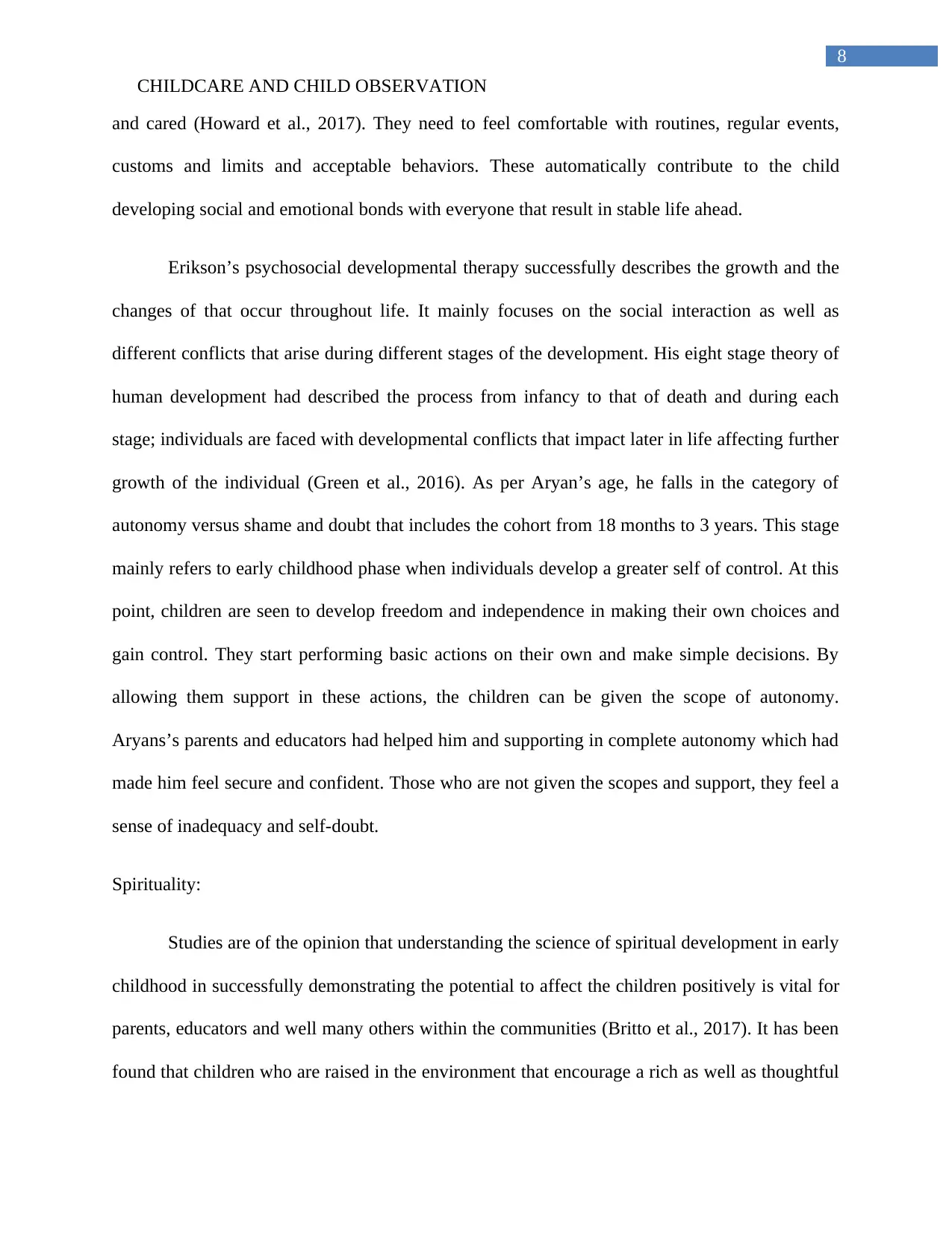
8
CHILDCARE AND CHILD OBSERVATION
and cared (Howard et al., 2017). They need to feel comfortable with routines, regular events,
customs and limits and acceptable behaviors. These automatically contribute to the child
developing social and emotional bonds with everyone that result in stable life ahead.
Erikson’s psychosocial developmental therapy successfully describes the growth and the
changes of that occur throughout life. It mainly focuses on the social interaction as well as
different conflicts that arise during different stages of the development. His eight stage theory of
human development had described the process from infancy to that of death and during each
stage; individuals are faced with developmental conflicts that impact later in life affecting further
growth of the individual (Green et al., 2016). As per Aryan’s age, he falls in the category of
autonomy versus shame and doubt that includes the cohort from 18 months to 3 years. This stage
mainly refers to early childhood phase when individuals develop a greater self of control. At this
point, children are seen to develop freedom and independence in making their own choices and
gain control. They start performing basic actions on their own and make simple decisions. By
allowing them support in these actions, the children can be given the scope of autonomy.
Aryans’s parents and educators had helped him and supporting in complete autonomy which had
made him feel secure and confident. Those who are not given the scopes and support, they feel a
sense of inadequacy and self-doubt.
Spirituality:
Studies are of the opinion that understanding the science of spiritual development in early
childhood in successfully demonstrating the potential to affect the children positively is vital for
parents, educators and well many others within the communities (Britto et al., 2017). It has been
found that children who are raised in the environment that encourage a rich as well as thoughtful
CHILDCARE AND CHILD OBSERVATION
and cared (Howard et al., 2017). They need to feel comfortable with routines, regular events,
customs and limits and acceptable behaviors. These automatically contribute to the child
developing social and emotional bonds with everyone that result in stable life ahead.
Erikson’s psychosocial developmental therapy successfully describes the growth and the
changes of that occur throughout life. It mainly focuses on the social interaction as well as
different conflicts that arise during different stages of the development. His eight stage theory of
human development had described the process from infancy to that of death and during each
stage; individuals are faced with developmental conflicts that impact later in life affecting further
growth of the individual (Green et al., 2016). As per Aryan’s age, he falls in the category of
autonomy versus shame and doubt that includes the cohort from 18 months to 3 years. This stage
mainly refers to early childhood phase when individuals develop a greater self of control. At this
point, children are seen to develop freedom and independence in making their own choices and
gain control. They start performing basic actions on their own and make simple decisions. By
allowing them support in these actions, the children can be given the scope of autonomy.
Aryans’s parents and educators had helped him and supporting in complete autonomy which had
made him feel secure and confident. Those who are not given the scopes and support, they feel a
sense of inadequacy and self-doubt.
Spirituality:
Studies are of the opinion that understanding the science of spiritual development in early
childhood in successfully demonstrating the potential to affect the children positively is vital for
parents, educators and well many others within the communities (Britto et al., 2017). It has been
found that children who are raised in the environment that encourage a rich as well as thoughtful
⊘ This is a preview!⊘
Do you want full access?
Subscribe today to unlock all pages.

Trusted by 1+ million students worldwide
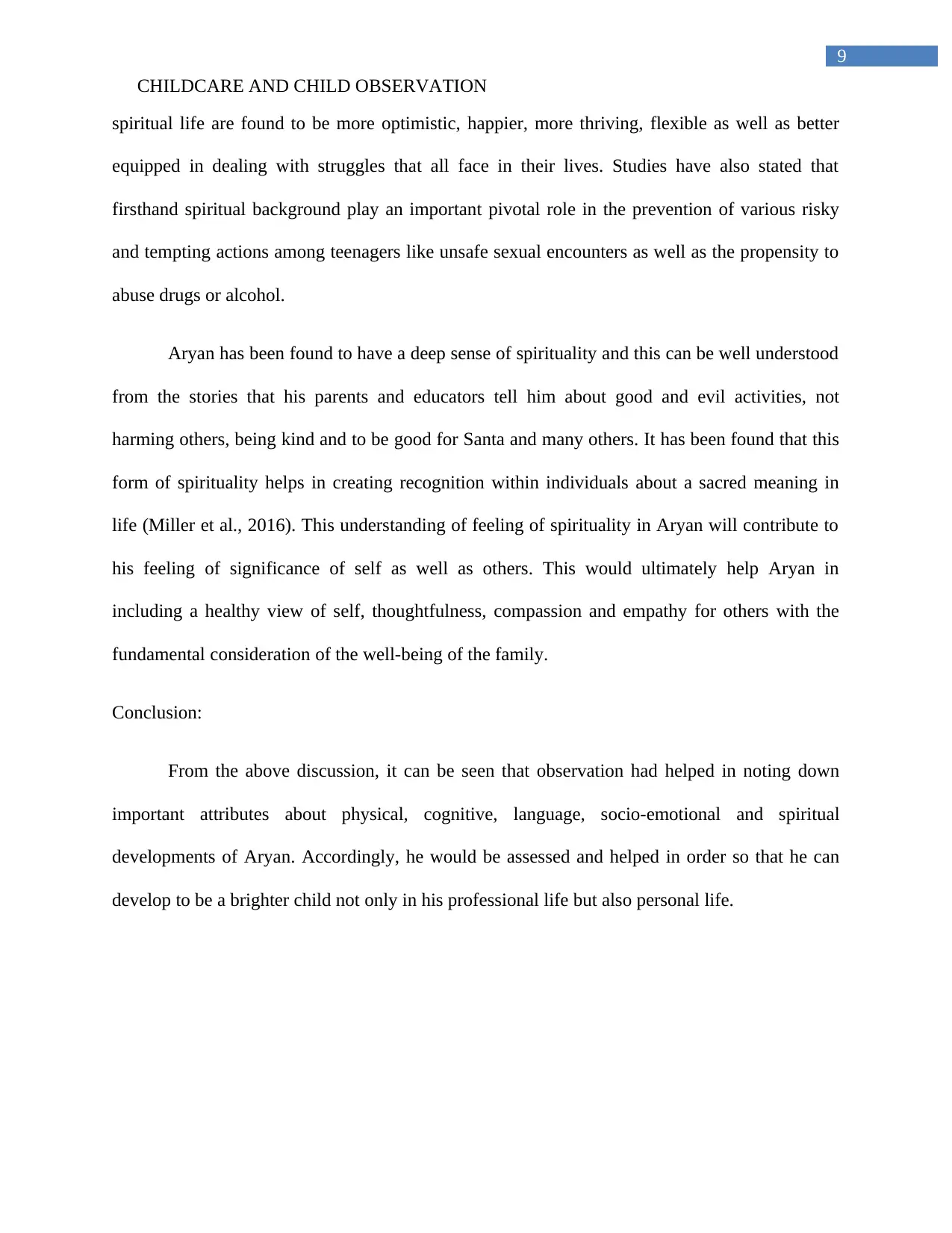
9
CHILDCARE AND CHILD OBSERVATION
spiritual life are found to be more optimistic, happier, more thriving, flexible as well as better
equipped in dealing with struggles that all face in their lives. Studies have also stated that
firsthand spiritual background play an important pivotal role in the prevention of various risky
and tempting actions among teenagers like unsafe sexual encounters as well as the propensity to
abuse drugs or alcohol.
Aryan has been found to have a deep sense of spirituality and this can be well understood
from the stories that his parents and educators tell him about good and evil activities, not
harming others, being kind and to be good for Santa and many others. It has been found that this
form of spirituality helps in creating recognition within individuals about a sacred meaning in
life (Miller et al., 2016). This understanding of feeling of spirituality in Aryan will contribute to
his feeling of significance of self as well as others. This would ultimately help Aryan in
including a healthy view of self, thoughtfulness, compassion and empathy for others with the
fundamental consideration of the well-being of the family.
Conclusion:
From the above discussion, it can be seen that observation had helped in noting down
important attributes about physical, cognitive, language, socio-emotional and spiritual
developments of Aryan. Accordingly, he would be assessed and helped in order so that he can
develop to be a brighter child not only in his professional life but also personal life.
CHILDCARE AND CHILD OBSERVATION
spiritual life are found to be more optimistic, happier, more thriving, flexible as well as better
equipped in dealing with struggles that all face in their lives. Studies have also stated that
firsthand spiritual background play an important pivotal role in the prevention of various risky
and tempting actions among teenagers like unsafe sexual encounters as well as the propensity to
abuse drugs or alcohol.
Aryan has been found to have a deep sense of spirituality and this can be well understood
from the stories that his parents and educators tell him about good and evil activities, not
harming others, being kind and to be good for Santa and many others. It has been found that this
form of spirituality helps in creating recognition within individuals about a sacred meaning in
life (Miller et al., 2016). This understanding of feeling of spirituality in Aryan will contribute to
his feeling of significance of self as well as others. This would ultimately help Aryan in
including a healthy view of self, thoughtfulness, compassion and empathy for others with the
fundamental consideration of the well-being of the family.
Conclusion:
From the above discussion, it can be seen that observation had helped in noting down
important attributes about physical, cognitive, language, socio-emotional and spiritual
developments of Aryan. Accordingly, he would be assessed and helped in order so that he can
develop to be a brighter child not only in his professional life but also personal life.
Paraphrase This Document
Need a fresh take? Get an instant paraphrase of this document with our AI Paraphraser
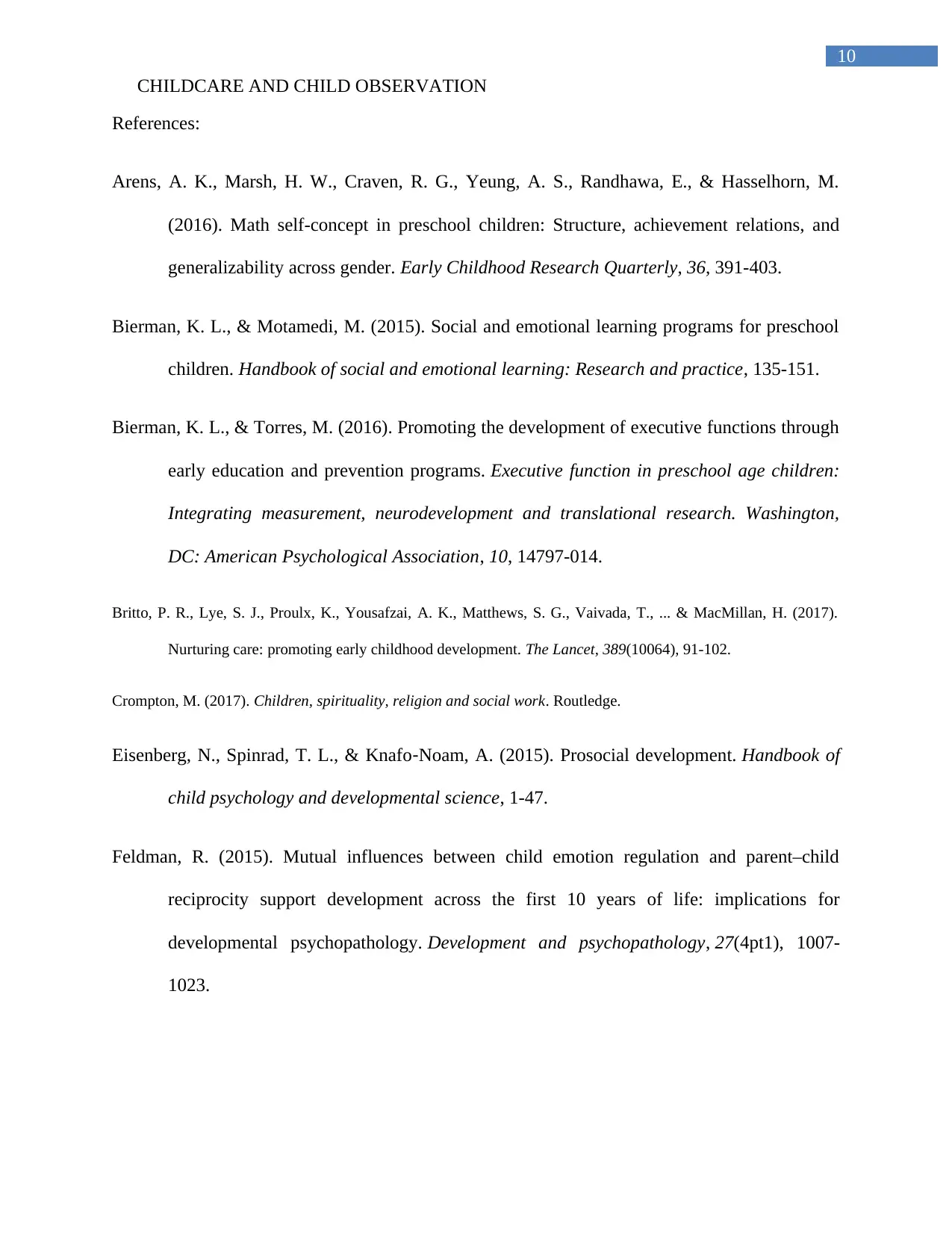
10
CHILDCARE AND CHILD OBSERVATION
References:
Arens, A. K., Marsh, H. W., Craven, R. G., Yeung, A. S., Randhawa, E., & Hasselhorn, M.
(2016). Math self-concept in preschool children: Structure, achievement relations, and
generalizability across gender. Early Childhood Research Quarterly, 36, 391-403.
Bierman, K. L., & Motamedi, M. (2015). Social and emotional learning programs for preschool
children. Handbook of social and emotional learning: Research and practice, 135-151.
Bierman, K. L., & Torres, M. (2016). Promoting the development of executive functions through
early education and prevention programs. Executive function in preschool age children:
Integrating measurement, neurodevelopment and translational research. Washington,
DC: American Psychological Association, 10, 14797-014.
Britto, P. R., Lye, S. J., Proulx, K., Yousafzai, A. K., Matthews, S. G., Vaivada, T., ... & MacMillan, H. (2017).
Nurturing care: promoting early childhood development. The Lancet, 389(10064), 91-102.
Crompton, M. (2017). Children, spirituality, religion and social work. Routledge.
Eisenberg, N., Spinrad, T. L., & Knafo‐Noam, A. (2015). Prosocial development. Handbook of
child psychology and developmental science, 1-47.
Feldman, R. (2015). Mutual influences between child emotion regulation and parent–child
reciprocity support development across the first 10 years of life: implications for
developmental psychopathology. Development and psychopathology, 27(4pt1), 1007-
1023.
CHILDCARE AND CHILD OBSERVATION
References:
Arens, A. K., Marsh, H. W., Craven, R. G., Yeung, A. S., Randhawa, E., & Hasselhorn, M.
(2016). Math self-concept in preschool children: Structure, achievement relations, and
generalizability across gender. Early Childhood Research Quarterly, 36, 391-403.
Bierman, K. L., & Motamedi, M. (2015). Social and emotional learning programs for preschool
children. Handbook of social and emotional learning: Research and practice, 135-151.
Bierman, K. L., & Torres, M. (2016). Promoting the development of executive functions through
early education and prevention programs. Executive function in preschool age children:
Integrating measurement, neurodevelopment and translational research. Washington,
DC: American Psychological Association, 10, 14797-014.
Britto, P. R., Lye, S. J., Proulx, K., Yousafzai, A. K., Matthews, S. G., Vaivada, T., ... & MacMillan, H. (2017).
Nurturing care: promoting early childhood development. The Lancet, 389(10064), 91-102.
Crompton, M. (2017). Children, spirituality, religion and social work. Routledge.
Eisenberg, N., Spinrad, T. L., & Knafo‐Noam, A. (2015). Prosocial development. Handbook of
child psychology and developmental science, 1-47.
Feldman, R. (2015). Mutual influences between child emotion regulation and parent–child
reciprocity support development across the first 10 years of life: implications for
developmental psychopathology. Development and psychopathology, 27(4pt1), 1007-
1023.
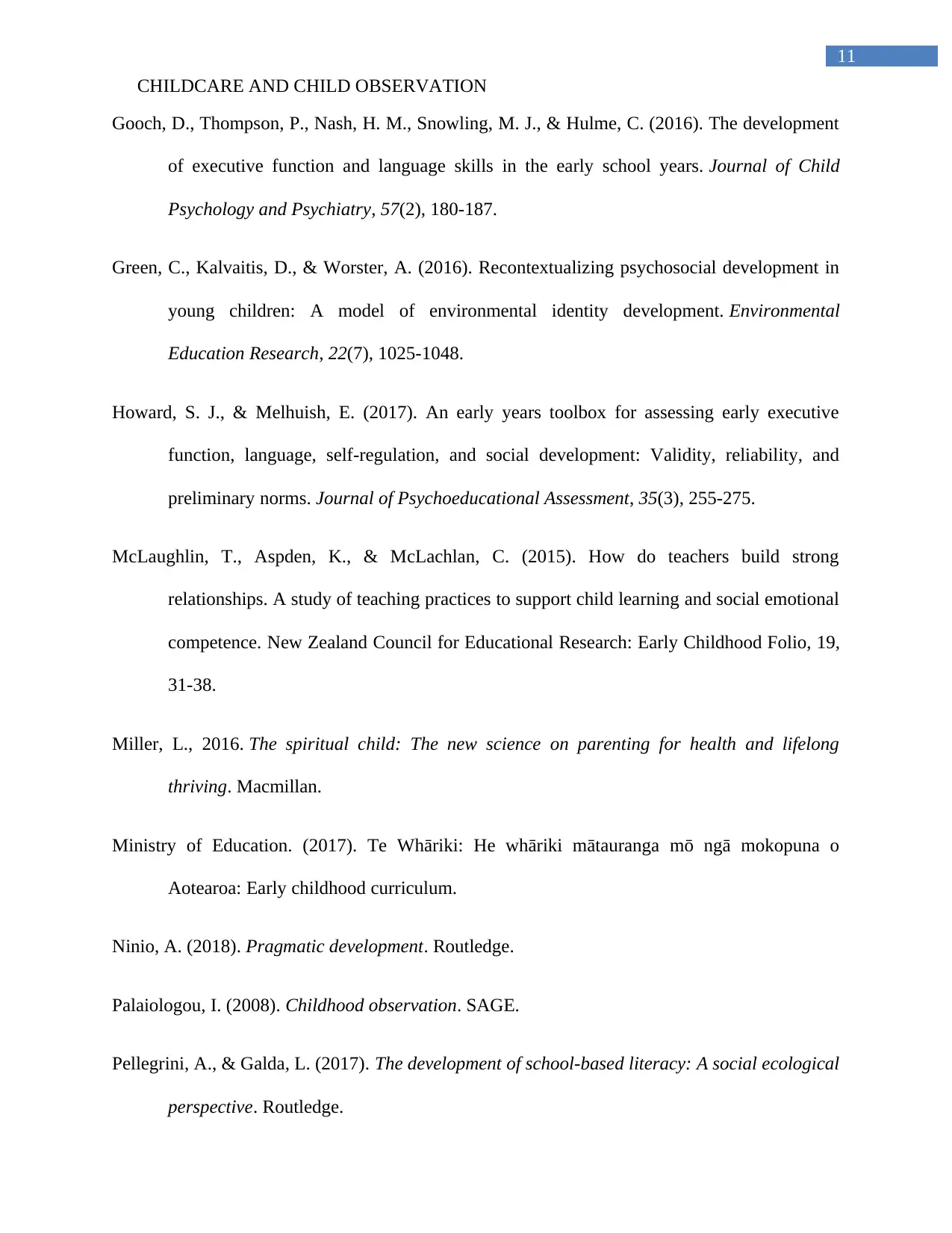
11
CHILDCARE AND CHILD OBSERVATION
Gooch, D., Thompson, P., Nash, H. M., Snowling, M. J., & Hulme, C. (2016). The development
of executive function and language skills in the early school years. Journal of Child
Psychology and Psychiatry, 57(2), 180-187.
Green, C., Kalvaitis, D., & Worster, A. (2016). Recontextualizing psychosocial development in
young children: A model of environmental identity development. Environmental
Education Research, 22(7), 1025-1048.
Howard, S. J., & Melhuish, E. (2017). An early years toolbox for assessing early executive
function, language, self-regulation, and social development: Validity, reliability, and
preliminary norms. Journal of Psychoeducational Assessment, 35(3), 255-275.
McLaughlin, T., Aspden, K., & McLachlan, C. (2015). How do teachers build strong
relationships. A study of teaching practices to support child learning and social emotional
competence. New Zealand Council for Educational Research: Early Childhood Folio, 19,
31-38.
Miller, L., 2016. The spiritual child: The new science on parenting for health and lifelong
thriving. Macmillan.
Ministry of Education. (2017). Te Whāriki: He whāriki mātauranga mō ngā mokopuna o
Aotearoa: Early childhood curriculum.
Ninio, A. (2018). Pragmatic development. Routledge.
Palaiologou, I. (2008). Childhood observation. SAGE.
Pellegrini, A., & Galda, L. (2017). The development of school-based literacy: A social ecological
perspective. Routledge.
CHILDCARE AND CHILD OBSERVATION
Gooch, D., Thompson, P., Nash, H. M., Snowling, M. J., & Hulme, C. (2016). The development
of executive function and language skills in the early school years. Journal of Child
Psychology and Psychiatry, 57(2), 180-187.
Green, C., Kalvaitis, D., & Worster, A. (2016). Recontextualizing psychosocial development in
young children: A model of environmental identity development. Environmental
Education Research, 22(7), 1025-1048.
Howard, S. J., & Melhuish, E. (2017). An early years toolbox for assessing early executive
function, language, self-regulation, and social development: Validity, reliability, and
preliminary norms. Journal of Psychoeducational Assessment, 35(3), 255-275.
McLaughlin, T., Aspden, K., & McLachlan, C. (2015). How do teachers build strong
relationships. A study of teaching practices to support child learning and social emotional
competence. New Zealand Council for Educational Research: Early Childhood Folio, 19,
31-38.
Miller, L., 2016. The spiritual child: The new science on parenting for health and lifelong
thriving. Macmillan.
Ministry of Education. (2017). Te Whāriki: He whāriki mātauranga mō ngā mokopuna o
Aotearoa: Early childhood curriculum.
Ninio, A. (2018). Pragmatic development. Routledge.
Palaiologou, I. (2008). Childhood observation. SAGE.
Pellegrini, A., & Galda, L. (2017). The development of school-based literacy: A social ecological
perspective. Routledge.
⊘ This is a preview!⊘
Do you want full access?
Subscribe today to unlock all pages.

Trusted by 1+ million students worldwide
1 out of 17
Related Documents
Your All-in-One AI-Powered Toolkit for Academic Success.
+13062052269
info@desklib.com
Available 24*7 on WhatsApp / Email
![[object Object]](/_next/static/media/star-bottom.7253800d.svg)
Unlock your academic potential
Copyright © 2020–2025 A2Z Services. All Rights Reserved. Developed and managed by ZUCOL.





